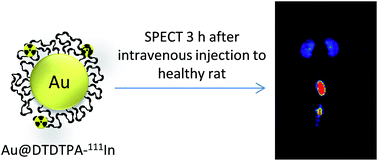The biodistribution of gold nanoparticles designed for renal clearance†
Abstract
Owing to their tunable optical properties and their high absorption cross-section of X- and γ-ray, gold

Maintenance work is planned for Wednesday 1st May 2024 from 9:00am to 11:00am (BST).
During this time, the performance of our website may be affected - searches may run slowly and some pages may be temporarily unavailable. If this happens, please try refreshing your web browser or try waiting two to three minutes before trying again.
We apologise for any inconvenience this might cause and thank you for your patience.
* Corresponding authors
a Laboratoire de Physico-Chimie des Matériaux Luminescents, UMR 5620 CNRS – UCBL, Université de Lyon, 22 Avenue Gaston Berger, 69622 Villeurbanne Cedex, France
b
Institut UTINAM, UMR 6213 CNRS-UFC, Université de Franche-Comté, 16 route de Gray, 25030 Besançon Cedex, France
E-mail:
stephane.roux@univ-fcomte.fr
Fax: +33 381 66 55 04
Tel: +33 381 66 62 99
c Matériaux Ingénierie et Science, UMR 5510 CNRS – INSA de Lyon, 7 Avenue Jean Capelle, 69621 Villeurbanne Cedex, France
Owing to their tunable optical properties and their high absorption cross-section of X- and γ-ray, gold

 Please wait while we load your content...
Something went wrong. Try again?
Please wait while we load your content...
Something went wrong. Try again?
C. Alric, I. Miladi, D. Kryza, J. Taleb, F. Lux, R. Bazzi, C. Billotey, M. Janier, P. Perriat, S. Roux and O. Tillement, Nanoscale, 2013, 5, 5930 DOI: 10.1039/C3NR00012E
To request permission to reproduce material from this article, please go to the Copyright Clearance Center request page.
If you are an author contributing to an RSC publication, you do not need to request permission provided correct acknowledgement is given.
If you are the author of this article, you do not need to request permission to reproduce figures and diagrams provided correct acknowledgement is given. If you want to reproduce the whole article in a third-party publication (excluding your thesis/dissertation for which permission is not required) please go to the Copyright Clearance Center request page.
Read more about how to correctly acknowledge RSC content.
 Fetching data from CrossRef.
Fetching data from CrossRef.
This may take some time to load.
Loading related content
